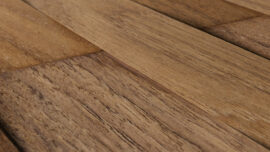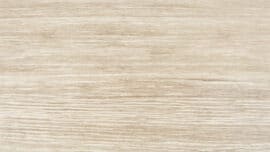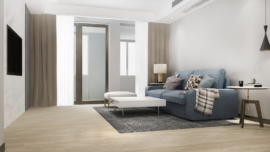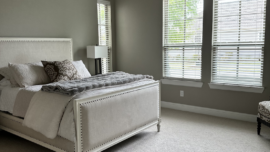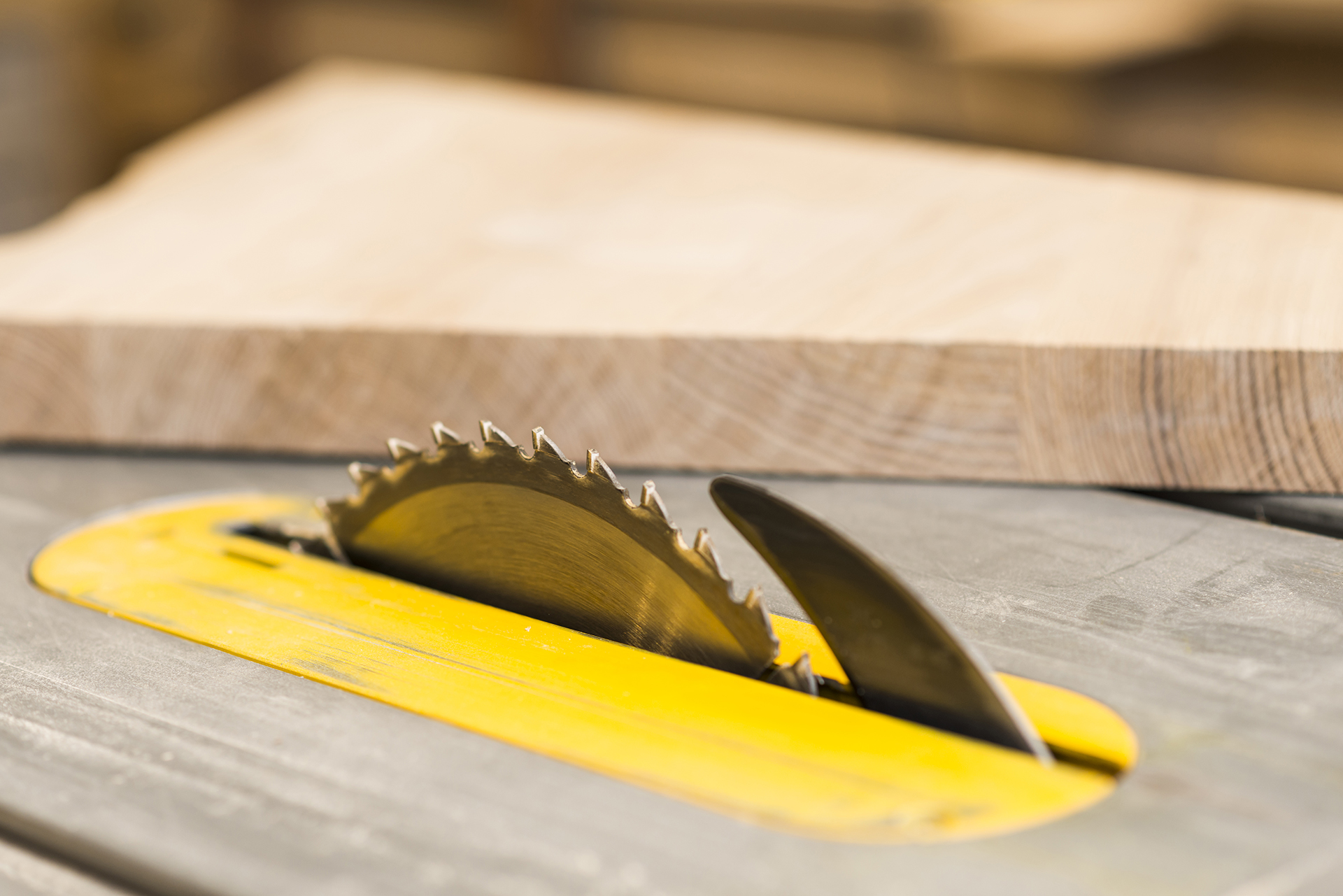
Plain Sawn vs. Quarter Sawn vs. Rift Sawn Flooring
Hardwood flooring is still a trendy option for homes today. When selecting the style you want, you may notice that the planks can look different.
When logs get cut, it usually occurs in one of three ways: plain sawn, rift sawn, or quarter sawn. Each of these lumber types is characterized by the orientation of the log and how it gets cut at the sawmill. The placement of the log dictates the growth ring orientation on the ends of each plank.
It can seem confusing, but keep reading to learn more about the differences between these cuts, how it affects the finished look, and why GC Flooring Pros offers the best installation services and variety.
Before we go into all of the details, here’s your quick answer:
Plain Sawn Wood Flooring
- Also known as flat sawn, it’s the most common cut of wood flooring.
- The log is cut straight through, resulting in planks with a varied grain pattern, including some curved or wavy lines.
- The planks have a more natural look and are less expensive compared to other cuts.
- The wood may be more prone to shrinkage, expansion, and cupping due to its grain pattern.
Quarter Sawn Wood Flooring
- The log is first cut into quarters, then each quarter is sawn perpendicular to the growth rings.
- The planks have a straight, uniform grain pattern with no wavy or curved lines.
- This cut makes the wood more stable, less prone to shrinkage and expansion, and less likely to warp or cup.
- The wood has a more consistent appearance and is often more expensive due to the additional time and effort required to produce it.
Rift Sawn Wood Flooring
- The log is first quartered, and then each quarter is cut at an angle between 30 and 60 degrees to the growth rings.
- The planks have a straight grain pattern with a tighter, more consistent look compared to plain sawn wood.
- This cut makes the wood more stable, less prone to shrinkage and expansion, and less likely to warp or cup.
- Rift sawn wood is more expensive due to the additional time and effort required to produce it.
- This type of wood flooring is less common than plain sawn flooring.
Now that we’ve recapped, let’s dive deeper.
What Is Plain Sawn Wood / What Is Flat Sawn Wood?
The most popular cut of lumber used on hardwood flooring is plain sawn lumber. Wider planks get produced by making parallel cuts through the log. To achieve the familiar “cathedral” grain, the annular growth rings are generally 30 degrees or less to the face of the board.
This particular cut is resourceful because it takes advantage of the entire log while reducing waste and optimizing yield. It is a much more effective milling method than rift or quarter sawing. Thanks to the efficacy of the product and its production, it is among the most affordable cuts of wood to boot.
The way that a board behaves is determined by how much it will move as the humidity fluctuates. Wood, even when dry, will continue to swell and shrink in width; however, the total amount that it moves is contingent on the grain direction.
For example, the tangential plain sawn grain is more unstable regarding dimensions than other cuts. Although these boards are strong, they can eventually have problems such as twisting, cupping, and warping.
What Is Quarter Sawn Wood?
Quarter sawn lumber is labeled as such logs are cut into four quarters. More specifically, the mill cuts a board from one flat plain, turns the log, and cuts the proceeding board—during the cutting; they continuously alternate it. Consequently, you end up with even narrower boards until there’s merely a wedge piece left behind.
Typically the growth rings are 60-90 degrees about the face of the board, giving a linear grain pattern absent the cathedral look. With White Oak or Red Oak, this cut displays a ray or flecking in the grain.
Because this kind of cut produces more waste and requires more labor, it’s more expensive than plain sawn lumber. Thanks to the position of the growth ring in the cut, when compared to plain sawn lumber, quarter sawn lumber is more dimensionally stable. Also, it resists contraction and expansion on the plank’s width.
What Is Rift Sawn Lumber?
The most elite cut is rift sawn lumber. You begin cutting the log into quarters just as you do with quarter sawn lumber. However, the most significant difference is that the mill cuts each quarter into a spiral pattern.
Next, to help understand the cuts of wood, you have to visualize the end of a log as circular rings like a clock’s face. Boards cut using the rifting method come out of sections at the 2, 4, 8, and 10 o’clock positions.
As you look at the end of the board, the pattern of the grain runs between 30 to 60 degrees from its face—when cut at the optimal cut of 45 degrees. The finished look is a linear, straight grain with a consistent and clean look.
Keep in mind that this method creates the most waste, which increases the cost of the material. However, rift sawn lumber is the most stable cut of lumber. Although it produces the most waste, the cut is most resistant to cupping or warping.
Key Takeaways
Here are the main ways that the wood cuts differ from one another:
Plain Sawn Vs. Quarter Sawn
Despite how aesthetically pleasing the surface of plain sawn wood is, there are a few drawbacks that home and business owners will want to be aware of as they’re making their decision for flooring.
As plain sawn wood ages and dries, the diverging grain can cause the boards to twist, cup, and maybe bow.
Quarter sawn planks, on the other hand, will remain relatively stable even when humidity levels fluctuate. Plain sawn pieces will be subject to contracting and expanding, so you might notice gaps in the winter or cupping during the summer. Nonetheless, plain sawn is very beautiful and doesn’t cost as much.
Quarter Sawn Vs. Rift Sawn
Rift sawn is very similar to quarter sawn, and these boards will be the most stable, but it’s close between these two types.
Still, rift sawn is the most wasteful, as large wedges of waste remain from every board. That factor makes this lumber expensive to produce, though the finished product is also elegant and less susceptible to warping.
Plain Sawn Vs. Rift Sawn
Generally, rift sawn planks get cut as complementary pieces to quarter sawn boards previously cut, and most people don’t choose this style.
Plain sawn boards are also usually wider than rift and quarter sawn boards. Compared to plain sawn, which is very affordable and popular, rift sawn is the least common option. However, each can be stained for a different look, though many people choose to leave the natural style intact.
Let Us Help You Choose!
GC Flooring Pros is a family-owned company that has taken pride in offering exceptional customer service and professional installation services to Frisco area residents for years. Our primary goal is to ensure that our clients feel they’ve had an excellent experience and wonderful value for their hard-earned money.
Extensive knowledge about flooring materials and installation techniques, as well as premier craftsmanship, make us a top contender to help deliver the flooring you need. At GC Flooring Pros, we offer affordable solutions, transparent communication, and efficient services from start to finish.
We have a vast selection of high-quality floors, from contemporary to classic and everything in between. Partnering with top brands and manufacturers worldwide helps us guarantee that you’ll have durable and beautiful floors for years to come.
GC Flooring can help you with your commercial or residential flooring needs, contact us today for more information and get a quote. We look forward to hearing from you!


